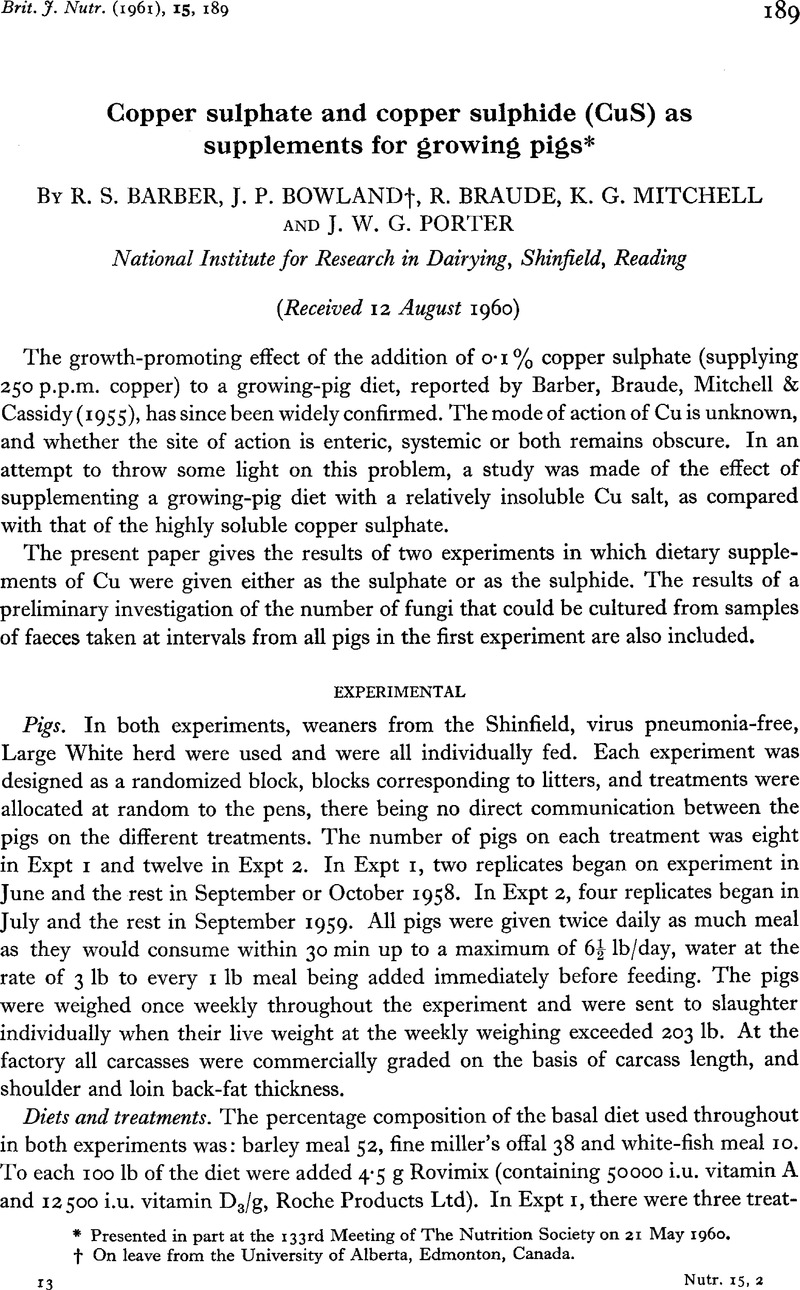Crossref Citations
This article has been cited by the following publications. This list is generated based on data provided by Crossref.
Allen, M. M.
Barber, R. S.
Braude, R.
and
Mitchell, K. G.
1961.
Further studies on various aspects of the use of high-copper supplements for growing pigs.
British Journal of Nutrition,
Vol. 15,
Issue. 4,
p.
507.
Barber, R. S.
Braude, R.
and
Mitchell, K. G.
1962.
Effect of including an antimycotic (griseofulvin) in the diet of growing pigs.
Animal Science,
Vol. 4,
Issue. 2,
p.
253.
Bowland, J. P.
Manns, J. G.
and
Zivković, S.
1963.
SOLVENT-EXTRACTED RAPESEED OIL MEAL AS A PROTEIN SOURCE FOR PIGS AND RATS: IV. LIVER WEIGHTS AND VITAMIN A STORAGE IN THE LIVER.
Canadian Journal of Animal Science,
Vol. 43,
Issue. 2,
p.
279.
TAYLOR, MICHAEL
and
THOMKE, SIGVARD
1964.
Effect of High-level Copper on the Depot Fat of Bacon Pigs.
Nature,
Vol. 201,
Issue. 4925,
p.
1246.
Smith, M. S.
1969.
Responses of chicks to dietary supplements of copper sulphate.
British Poultry Science,
Vol. 10,
Issue. 2,
p.
97.
Husbands, D. R.
1972.
The effect of dietary copper on the composition of adipose tissue triglycerides in the broiler chicken1.
British Poultry Science,
Vol. 13,
Issue. 2,
p.
201.
MYRES, A. W.
and
BOWLAND, J. P.
1973.
EFFECTS OF ENVIRONMENTAL TEMPERATURE AND DIETARY COPPER ON GROWTH AND LIPID METABOLISM IN PIGS. I. GROWTH, CARCASS QUALITY, AND TISSUE COPPER LEVELS.
Canadian Journal of Animal Science,
Vol. 53,
Issue. 1,
p.
115.
Barber, R. S.
Braude, R.
and
Mitchell, K. G.
1974.
A note on further studies on sodium salicylate as a growth stimulant for growing pigs receiving diets with or without copper sulphate.
Animal Science,
Vol. 18,
Issue. 2,
p.
219.
Cooke, B. C.
1981.
Copper in Animal Wastes and Sewage Sludge.
p.
327.
Lenis, N. P.
1981.
Copper in Animal Wastes and Sewage Sludge.
p.
61.
CUNNANE, STEPHEN C.
1984.
Fats in Animal Nutrition.
p.
167.
Rowan, G.
and
Lawrence, T. L. J.
1986.
Growth, tissue deposition and metabolism studies in growing pigs given low glucosinolate rapeseed meal diets containing different amounts of copper and polyethylene glycol.
The Journal of Agricultural Science,
Vol. 107,
Issue. 3,
p.
505.
Baker, D.H.
1991.
Swine Nutrition.
p.
341.
Baker, David H.
and
Ammerman, Clarence B.
1995.
Bioavailability of Nutrients for Animals.
p.
127.
Baker, David
2000.
Swine Nutrition, Second Edition.
Baker, David H.
and
Stein, Hans H.
2013.
Sustainable Swine Nutrition.
p.
341.
Guo, Jianying
Bai, Yuman
Liao, Jianzhao
Wang, Shuzhou
Han, Qingyue
and
Tang, Zhaoxin
2020.
Copper Induces Apoptosis Through Endoplasmic Reticulum Stress in Skeletal Muscle of Broilers.
Biological Trace Element Research,
Vol. 198,
Issue. 2,
p.
636.
Lee, Su A.
and
Stein, Hans H.
2022.
Sustainable Swine Nutrition.
p.
493.
Davin, Roger
Lagos, L. Vanessa
and
Molist, Francesc
2022.
Short communication: Copper bis-glycinate can partially or totally replace copper sulfate in diets with either no effects or positive effects on growth performance of weaned pigs.
Animal Feed Science and Technology,
Vol. 285,
Issue. ,
p.
115223.
Ma, Feiyang
Huo, Yihui
Li, Huayu
Yang, Fan
Liao, Jianzhao
Han, Qingyue
Li, Ying
Pan, Jiaqiang
Hu, Lianmei
Guo, Jianying
and
Tang, Zhaoxin
2022.
New insights into the interaction between duodenal toxicity and microbiota disorder under copper exposure in chicken: Involving in endoplasmic reticulum stress and mitochondrial toxicity.
Chemico-Biological Interactions,
Vol. 366,
Issue. ,
p.
110132.



